
|
May 2009
|
|
|
The U.S. Department of Energy's Thomas Jefferson National Accelerator Facility
|
|
Jefferson Lab Breaks Ground On $310 Million Project |
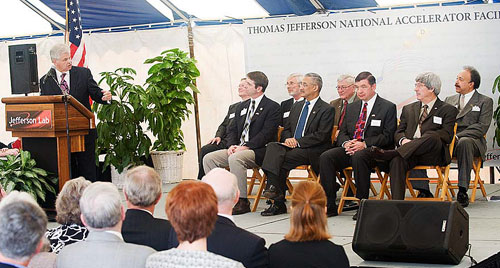 Newport News Mayor Joe Frank addresses the crowd at the groundbreaking ceremony for the Jefferson Lab 12 GeV Upgrade. Also on the stage are (front row, l-r) U.S. Rep. Rob Wittman of Virginia’s 1st District; U.S. Rep. Bobby Scott of Virginia’s 3rd District; Gene Henry, acting associate director of DOE’s Office of Science for Nuclear Physics; Jefferson Lab Director Hugh Montgomery; (back row, l-r) DOE Jefferson Site Office Manager Jim Turi; former Jefferson Lab Director Christoph Leemann; former Jefferson Lab Director Hermann Grunder; and Hampton University President William Harvey.
Jefferson Lab marked the beginning of construction of its $310 million 12 GeV Upgrade project with a groundbreaking ceremony on April 14 that was attended by more than 400 people, including local, state and national political leaders. "This important $310 million project will further enhance Jefferson Lab's national and international reputation and will provide scientists across the nation and around the world with a new tool for exploring the atom," said U.S. Rep. Bobby Scott of Virginia's 3rd District. "What a great day," added U.S. Rep. Rob Wittman of Virginia's 1st District. "I see it as a great day for our nation, a great day for the Commonwealth of Virginia, a great day for the Newport News community and, above all, a great day for science."..... more |
|
|
JLab Undergoes a Renascence
|
Lab To Receive $75 Million In Recovery Act Funding
|
Ready, Set, Go! To the 2009 JAG Run-A-Round
|
||
|
|
||||
Below the Fold:
|
||||
Jefferson Lab Breaks Ground On $310 Million Project |
 Newport News Mayor Joe Frank addresses the crowd at the groundbreaking ceremony for the Jefferson Lab 12 GeV Upgrade. Also on the stage are (front row, l-r) U.S. Rep. Rob Wittman of Virginia’s 1st District; U.S. Rep. Bobby Scott of Virginia’s 3rd District; Gene Henry, acting associate director of DOE’s Office of Science for Nuclear Physics; Jefferson Lab Director Hugh Montgomery; (back row, l-r) DOE Jefferson Site Office Manager Jim Turi; former Jefferson Lab Director Christoph Leemann; former Jefferson Lab Director Hermann Grunder; and Hampton University President William Harvey.
Jefferson Lab marked the beginning of construction of its $310 million 12 GeV Upgrade project with a groundbreaking ceremony on April 14 that was attended by more than 400 people, including local, state and national political leaders. "This important $310 million project will further enhance Jefferson Lab's national and international reputation and will provide scientists across the nation and around the world with a new tool for exploring the atom," said U.S. Rep. Bobby Scott of Virginia's 3rd District. "What a great day," added U.S. Rep. Rob Wittman of Virginia's 1st District. "I see it as a great day for our nation, a great day for the Commonwealth of Virginia, a great day for the Newport News community and, above all, a great day for science." Jefferson Lab is devoted to the study of the building blocks of matter — quarks and gluons. The 12 GeV Upgrade, which will be completed in 2015, will double the power of the lab's electron beam accelerator, up from the current 6 billion electron volts. The upgrade project, which also includes the construction of a fourth experimental hall, a 250-foot extension to the lab's underground accelerator tunnel, and new roads and utilities, recently received $65 million in stimulus funds to accelerate work. "When the upgrade is completed in the year 2015, we will have a facility that will provide scientists with an unprecedented tool for studying the nucleus of the atom. And I believe it will help us add significantly to our understanding of our world and our universe," said Jefferson Lab Director Hugh Montgomery. Gene Henry, acting associate director of the DOE's Office of Science for Nuclear Physics, noted that the upgrade "will give the U.S. nuclear physics community unprecedented capabilities for discovery and a deeper understanding of nuclear science. These capabilities will be unique in the world." 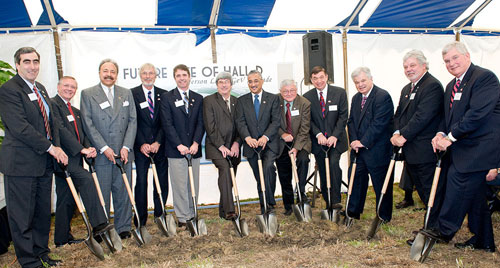 With shovels at the ready to celebrate JLab's 12 GeV Upgrade project groundbreaking are: (l-r) Delegate Glen Oder of the 94th District; DOE Jefferson Site Office Manager Jim Turi; Hampton University President William Harvey; former Jefferson Lab Director Christoph Leemann; U.S. Rep. Rob Wittman of Virginia’s 1st District; Jefferson Lab Director Hugh Montgomery; U.S. Rep. Bobby Scott of Virginia’s 3rd District; former Jefferson Lab Director Hermann Grunder; Gene Henry, acting associate director of DOE's Office of Science for Nuclear Physics; Newport News Mayor Joe Frank; Delegate Phil Hamilton of the 93rd District; and Virginia State Senator John Miller of the 1st District.
“The 12 GeV Project guarantees the lab’s future well beyond the next decade. It will allow the U.S. to strengthen its science base and maintain its place as a world leader in science and technology. It also will allow the lab to pursue broader, more effective collaborations, while training the next generation of scientists and engineers,” said James Turi, DOE site manager for Jefferson Lab. "It is exciting to see the ground being broken for this new world-class facility right here in Newport News," said Newport News Mayor Joe Frank. "But it's most exciting to understand the possibilities and potentials: When we can look at quarks and gluons and try to understand the essence of matter. When we can try to understand when energy is generated, what the implications of that are in the scientific world and, ultimately, to the everyday world that you and I live in." Hampton University President William Harvey said the project represents a much-needed investment in science. "Promoting science literacy and developing the next generation of science researchers, in my judgment, are the key factors to the pre-eminence of the United States economy," Harvey said. "Now, while the economy may be challenging at times, this should only emphasize the importance of scientific knowledge, scientific research, scientific training to rebuild and reinforce the basic building blocks for a vibrant country. I congratulate all of you who have worked to get to this day. And like all of you, I look forward to the decades of discovery-caliber science to come." |
JLab Undergoes a Renascence |
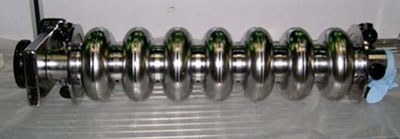 This is a photo of the seven-cell, high-gradient version of a CEBAF accelerator cavity.
Renascence: (n) a rebirth, Renaissance Accelerator technology is undergoing a renaissance at Jefferson Lab. A new section of the accelerator, called Renascence, features accelerator cavity technology that will provide the backbone of the 12 GeV Upgrade. The workhorses of Jefferson Lab's CEBAF are the accelerator cavities. The cavities store the radiofrequency waves used to energize electrons for nuclear physics experiments. While the cavities have proven their mettle over a decade of service, accelerator scientists are researching ways to improve the technology for future accelerators, such as Jefferson Lab's 12 GeV Upgrade. According to Charlie Reece, deputy director of the Institute for Superconducting Radiofrequency Science and Technology, there have been two competing ideas for improving the efficiency of the cavities. Both involve changing the shape of the doughnut-style sections of the cavities. Whipping Cavities into Shape CEBAF accelerator cavities are superconducting and made of niobium, which allows the cavities to efficiently energize electrons at an operating temperature near absolute zero. Because the cavities contain no moving parts, their efficiency is determined by their shape and their surface quality. 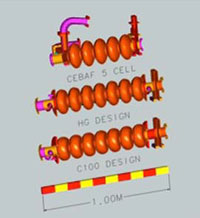 This graphic shows the differing cavity cell shapes of the original CEBAF five-cell design, the high-gradient seven-cell design and the low-loss (C100) design. The low-loss design will be used for the 12 GeV Upgrade. CAD drawing by Jim Henry, Engineering Division
"Subtle changes in the shape have beneficial effects," Reece explains. Researchers pored over CEBAF operations data to see how well the original CEBAF cavities, a design that originated at Cornell University, accelerated electrons and what improvements could be made. "Historically, the performance-limiting problem for CEBAF was field-emission," Reece says. This problem is caused by tiny nubbins of material on the inside surface of the cavity. These nubbins roguishly spew out wayward electrons that absorb the radiofrequency energy. The wayward electrons then plow into the cavity wall, heating it and essentially shorting out the cavity. One way to prevent this problem is to minimize the electric fields these nubbins are exposed to. "If that's what you're concerned about, you build a cavity that has the minimum surface electric fields on the wall, compared to the field that's accelerating the beam. That design is the high-gradient cavity shape," Reece explains. Though superconducting at low temperatures, the cavities generate some heat during operation. If the cavities generate more heat than the super-cold liquid helium circulating around the cavities can carry away, the cavities lose their superconductivity. So, researchers sought a cavity shape to minimize the cavity-generated heat. The low-loss cavity shape provides the same acceleration, with about 20 percent less heat, Reece says. Renascence the Cryomodule Both the high-gradient and low-loss cavity designs are featured in Renascence. Renascence is the third of a series of test cryomodules built since CEBAF began operation. Installed in the CEBAF accelerator for testing in 2007, Renascence is a modular section of the accelerator that contains eight cavities and much of the associated equipment needed to operate them. There are five so-called, high-gradient cavities in Renascence and three low-loss. Of those, three high-gradient cavities are not performing well. "One has a tuner problem, one of them we believe was damaged in high-pressure rinse processing, and the window leaks on another one," Reece says. "The rest are performing quite nicely." 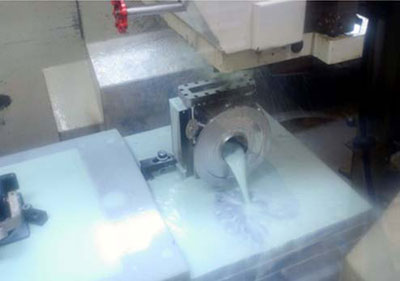 Pictured here is a portion of the endgroup components for a Renascence cavity during the machining process.
The researchers also used the cryomodule to test other new concepts. For instance, the cryomodule contains new HOM couplers. Higher-order modes are akin to the overtone of harmonic frequencies that you hear when you pluck a chord on a guitar. Accelerator cavities store radiofrequency energy by vibrating much like a guitar string. Like the string, they also can resonate at extra harmonic frequencies, which interfere with the cavity's operation. HOM couplers damp those harmonics. The current CEBAF cryomodules use coupler technology developed at Cornell, while the new couplers were designed at DESY and adapted for use at JLab. "The amount of HOM damping in the original CEBAF cavities was extremely generous, but we found that we could get by with much less. So we designed the damping to meet the new cavities' specification," Reece explains. "Unfortunately, some last-minute changes to the couplers to address a cooling problem created a damping problem in one of the Renascence cavities. This caused some operational issues last year, but also presented the accelerator physicists a rare opportunity to thoroughly study what happens when the damping is not quite strong enough." In addition, design changes also were made to accommodate the newer cavities, which are longer. The original CEBAF cavities contained five cells. Newer designs use seven, so some equipment between the cavities was streamlined. Other new technologies tested in Renascence include new gaskets, flanges, a new clamp developed at Jefferson Lab, refinements to insulation in the cryomodule and other improvements. 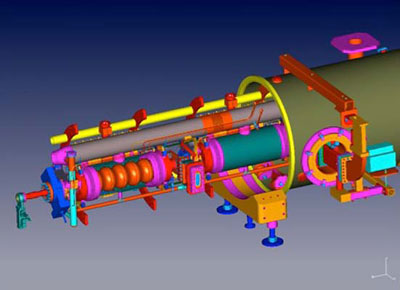 This is a computer-aided design drawing of a CEBAF Upgrade cryomodule. The cavities (orange) reside inside helium vessels (teal and pink). Also shown is a liquid helium delivery pipe (grey), structural supports (yellow and red) and fundamental power input couplers (flat orange pipes entering module). CAD drawing by Jim Henry, Engineering Division
Renascence at Work Although Renascence has exhibited some problems, it was among the best-performing cryomodules in the accelerator until its removal in March due to input radiofrequency window leaks into the beam line, even with only five of eight cavities running. Reece says that cryomodule designers have learned a lot from Renascence and their testing has provided invaluable information. "This Renascence module was an extremely fruitful prototype for Jefferson Lab; it was extremely valuable. The 12 GeV Upgrade Project will be much more robust because of what we have been able to learn from it," Reece concludes. Plans are being developed to rework the Renascence cryomodule after CEBAF is strong enough to support the 6 GeV physics program without it. Perhaps it will emerge yet again with a new lease on life – living up to its name. By Kandice Carter |
Lab To Receive $75 Million In Recovery Act Funding |
|
The U.S. Department of Energy announced in March that Jefferson Lab will receive $75 million from President Obama's American Recovery and Reinvestment Act to fund construction of JLab's 12 GeV Upgrade project and to modernize infrastructure. The funds are part of $1.2 billion announced by Secretary of Energy Steven Chu on March 23 from funding allocated under the Recovery Act to DOE's Office of Science. The funds will support an array of Office of Science-sponsored construction, laboratory infrastructure, and research projects across the nation. The secretary made the announcement during a visit to Brookhaven National Laboratory, in Upton, N.Y. "Leadership in science remains vital to America's economic prosperity, energy security, and global competitiveness," said Chu. "These projects not only provide critically needed short-term economic relief but also represent a strategic investment in our nation's future. They will create thousands of jobs and breathe new life into many local economies, while helping to accelerate new technology development, renew our scientific and engineering workforce, and modernize our nation's scientific infrastructure." Of the $75 million for Jefferson Lab, $65 million will be applied to the 12 GeV Upgrade project. When complete, the project will allow the lab’s international community of physicists to continue Jefferson Lab’s mission of expanding our knowledge of nuclear and particle physics with an unprecedented level of precision. The 12 GeV Upgrade is a $310 million project that will begin construction this spring and will be completed in 2015. The additional $10 million will be used to modernize lab facilities and infrastructure. "The ARRA funding will secure Jefferson Lab's position as a world-leading nuclear physics research facility far into the future, while creating jobs and providing an economic stimulus that are needed now in the Hampton Roads region and the Commonwealth of Virginia," said Jefferson Lab Director Hugh Montgomery. |
Ready, Set, Go! To the 2009 JAG Run-A-Round |
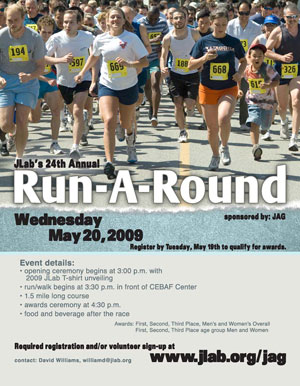
Timeline Reminders
Dust off those running shoes! The 24th annual Jefferson Activities Group Run-A-Round will be held Wednesday, May 20 from 3-6 p.m. Jefferson Lab staff, users, full-time contractors and immediate family members are invited to participate. Staff and users that participate can receive a free 2009 JLab T-shirt by turning in their Run-A-Round bibs at the T-shirt distribution tent. The event will begin in front of CEBAF Center at 3 p.m. with the debut of the 2009 T-shirt. The run/walk will start promptly at 3:30 p.m., following the same 1.5 mile course used last year. The finish line will be east of CEBAF Center, where the parking lot intersects with Rattley Road. The Peninsula Track Club will collect official times at the finish line. Food and beverages, music and the awards presentations will follow the race on Rattley Road. Awards will go to the top three male and female finishers in each age group and the top three overall fastest male and female finishers. If you want to train for the Run-A-Round, check out the suggestions and ideas here: http://www.jlab.org/jag/runaround/train/. JAG Remembers Young Engineer Through Spirit Award Run-A-Round Registration Late registration will be from 9 a.m. to 2 p.m. on Wednesday, May 20 in the CEBAF Center lobby. However, individuals registering the day of the race won't be eligible for awards. Volunteers Needed
Event Closes JLab Roads During the Run-A-Round (3:15 to 4:30 p.m.), the following streets will be closed to traffic for runner/walker safety: JLab’s main entrance (Onnes Drive), SURA Road, Lawrence Drive, Hofstadter Road and Rutherford Road (the parking lot between the VARC and CEBAF Center). If you will need to leave JLab during that time, please park your car at the ARC parking lot. |
JLab Awards $3.54 Million Contract To Pennsylvania Firm for 12 GeV ProjectA Pennsylvania company has been awarded a $3.54 million contract to provide 84 klystrons to Jefferson Lab. The 13-kW (kilowatt) klystrons, devices which will generate the electromagnetic fields that will accelerate the CEBAF electron beam, will be used in the construction of the lab’s 12 GeV Upgrade, a $310 million project that will provide an international community of physicists with a cutting-edge facility for studying the basic building blocks of the visible universe. L-3 Communications, based in Williamsport, Penn., was awarded the contract for the klystrons after a competitive bid process. The upgrade will double the energy of the lab’s electron beam from 6 billion electron volts (GeV) to 12 GeV. Construction on the project began this spring. Senegal Physicist Visits JLab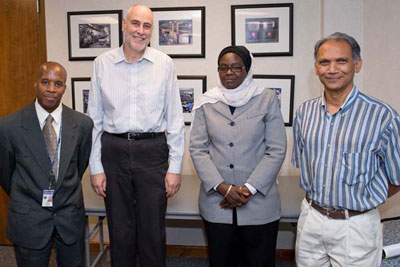 Paul Gueye, Hampton University professor and JLab user (left to right); Accelerator Division Associate Director Andrew Hutton; Ndeye Arame Boye-Faye, Senegal's Director of Research at the Ministry of Biofuels, Renewable Energy and Scientific Research; and Hari Areti, education and outreach manager for the Accelerator Division, pause for a picture during Boye-Faye's visit to the lab. Earlier in the afternoon she met with Physics Division Associate Director Larry Cardman and Rolf Ent, representing JLab's physics program; Drew Weisenberger, Detector & Imaging Group leader, and Latifa Elouadrhiri, 12 GeV staff scientist, regarding Africa conferences.
The West African nation of Senegal sent a special envoy to Jefferson Lab recently. Ndeye Arame Boye-Faye, Director of Research at the Ministry of Biofuels, Renewable Energy and Scientific Research, and professor at the University Cheikh Anta Diop in Dakar, stopped briefly in Hampton Roads to visit Jefferson Lab and Hampton University on March 17. She made the visit after presenting an invited talk at the 2009 March Meeting of the American Physical Society in Pittsburgh in a session “Physics in Africa” co-organized by Paul Gueye, a Hampton University professor and Jefferson Lab user. "Physics is a fantastic field. In our countries in Africa in general and in Senegal, we are doing physics, but are missing hands-on activities at the high-school level and virtually no high-level research facilities," she explained. To acquire more hands-on, or experimental, research opportunities, Boye-Faye is interested in starting collaborations with scientific institutions that have research programs aligned with Senegalese research interests. "We are trying to implement a nuclear high-energy physics/accelerator physics program that will provide unique training for students and faculty, and we intend to be strongly coupled to the planned medical physics program. Both are part of a global effort for a future international facility. So this is why I am here," she said. One major stumbling block to establishing more experimental facilities is the dearth of science funding in this small African nation. The Republic of Senegal is about the size of South Dakota but is home to 11.7 million. Research is supported by a fund called Fonds d’Impulsion de la Recherché Scientifique et Technique, or FIRST. The fund totals just $700,000 annually for all sciences. Boye-Faye believes the best way to overcome this funding problem is by "making science the driving force for our economic development. And for that, we have to establish collaborative research programs." Accompanied by Gueye, she met with lab leadership during her brief visit. Both Boye-Faye and Gueye are confident that her visit to Hampton University and Jefferson Lab has sparked interest in collaboration. Direct outcomes following her visit are the start of a nuclear physics Ph.D. thesis of a Senegalese student on Jefferson Lab research this fall, co-sponsoring of a Geant4 tutorial (programming application for nuclear and accelerator physics) in Dakar in June by JLab, and initial discussions for the JLab staff and user community to be part of the above-mentioned effort. "Right now we have big issues in science and in physics in general to overcome in Africa. And by setting up these collaborative research programs, I am sure we are going to do something very nice," she said. With Help From JLab, New Biopsy Imager Comes Online at WVU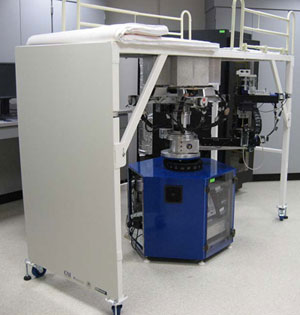 This photo shows the gantry for the new breast imaging/biopsy system now going through clinical trials at West Virginia University. The system was developed in part by members of JLab's Radiation Detector and Imaging Group.
A PEM/PET system (positron emission mammography/tomography breast imaging and biopsy) designed for detecting and guiding the biopsies of suspicious breast tumors is now in clinical testing at West Virginia University. The first patient was scanned with the device on Feb. 6, and by mid-March four patients had been scanned. The technology is built on traditional PET imaging, where a drug with a radiation-emitting component is injected into a patient and is then imaged. A movable array of two pairs of two flat scanners detect the radiation from the drug, and a sophisticated software package produces a three-dimensional image from scanner information. If a suspected lesion is found, the images can be used to guide a needle biopsy of the lesion. The biopsy is performed with a computer and human-controlled robotic arm. The system is the brainchild of Raymond Raylman, Ph.D., a professor of Radiology and vice chair of Radiology Research at WVU. The PEM/PET unit was designed and constructed by scientists and engineers from Jefferson Lab's Radiation Detector and Imaging Group, West Virginia University, the University of Washington and the University of Maryland School of Medicine. The system is more fully described in a JLab story from February 2008 titled: Jefferson Lab imager can detect beginnings of breast tumors FEL Joins With Others in New Research Venture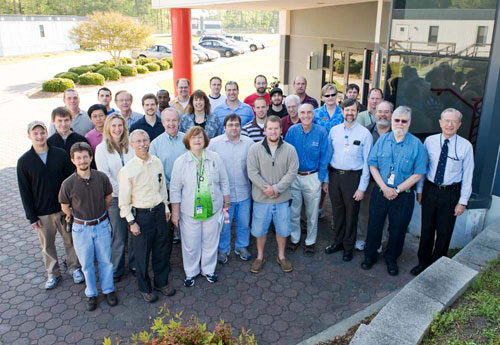 The Free-Electron Laser Division gathered recently for a group photo at the main entrance to the FEL Facility. FEL Division Associate Director George Neil stands in the front row, second from left.
Jefferson Lab will participate in a $777 million federal effort to accelerate scientific breakthroughs. JLab will be among nine universities and six Department of Energy labs collaborating with the Carnegie Geophysical Institution of Washington, D.C., under an Energy Frontier Research Center award announced Monday by the White House. DOE plans to fund the center at Carnegie Geophysical Institution at a level of $3 million a year for five years. Jefferson Lab’s unique Free-Electron Laser will be used by researchers as they study the behavior of materials relevant to novel energy production, and energy storage, distribution and utilization. The collaborators will study metals under extreme environments (nuclear power); superconductivity (power transmission and energy efficient devices); electronic and magnetic materials (energy transfer); hydrogen and hydrogen-bearing materials (energy storage); and nanophase, composite, and geological materials (novel materials). A total of 46 research projects were selected by DOE’s Office of Science to become Energy Frontier Research Centers. The 46 EFRCs were selected from a pool of 260 applications. The centers will be established at universities, national laboratories, nonprofit organizations and private firms across the nation. The centers are supported, in part, by funds made available under the American Recovery and Reinvestment Act. It is expected that the EFRCs will bring together groups of leading scientists to address fundamental issues in fields ranging from solar energy and electricity storage to materials sciences, biofuels, advanced nuclear systems, and carbon capture and sequestration. JLab’s Free-Electron Laser is the world’s most powerful, tunable free-electron laser. It uses the same superconducting radiofrequency technology that the lab uses to conduct is nuclear physics research. D.G.S. Painting Recognized as Top Small Business Subcontractor for 2008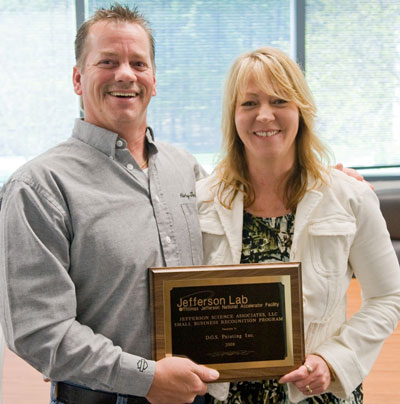 D.G.S. President Ruth Seeley and her husband, Don, vice president and project manager, received the 2008 Jefferson Science Associates/JLab Outstanding Small Business Subcontractor award.
A Yorktown-based business that provides a range of custom-painting services has been recognized as Jefferson Lab's Outstanding Small Business Subcontractor of the Year for 2008. Ruth Seeley, D.G.S. Painting Inc. president, and her husband, Don, vice president and project manager, received the Jefferson Science Associates/JLab Outstanding Small Business Subcontractor award at a reception held at the lab on April 22. Department of Energy officials, senior Jefferson Lab management, Procurement and Facilities Management & Logistics staff gathered to congratulate the Seeleys as they accepted the award plaque from Hugh Montgomery, Jefferson Lab director. "This is a tough competition," noted Danny Lloyd, JLab's small business program manager. "Jefferson Lab subcontracts a broad range of services and D.G.S. is one of several hundred small businesses that work with JLab. Using the lab's established criteria for the award, the award committee reviewed the top seven small businesses and made the winning selection. D.G.S. Painting is very responsive and provides high-quality painting support to Jefferson Lab. "Notably," Lloyd added, "Since 1999 when the lab started recording subcontractor hours on site, D.G.S. Painting has logged more than 6,230 labor hours without a safety violation. D.G.S. is a valued member of the JLab team." "Your efforts are much appreciated here," JLab Director Hugh Montgomery said to the Seeleys. "Small businesses such as yours are a valuable commodity; about 50 percent of our procurements are through small businesses." D.G.S., founded in 1992, began providing custom painting, wallboarding, carpentry and pressure-washing services to the lab in 1995. Since then, the company has completed more than 330 JLab task orders. Website Helps Students Prepare For Virginia Standards of Learning TestsAlong with the return of warm weather and blooming flowers, another sure sign of spring is increased usage of Jefferson Lab Science Education website. Thousands of Virginia students swamp the website each spring because it features samples of the Virginia Standards of Learning tests, which students must take each spring. "The most frequently accessed pages on the website include the Virginia Standards of Learning Science, Math and Technology Practice Tests and our 'Who Wants to Win $1,000,000 Math and Science Quiz,'" says Steve Gagnon, Jefferson Lab Science Education technician and webmaster. The education website includes questions from the recently released 2008 Virginia SOL tests, as well as test questions going back to 2000. Test categories include third-grade math and science; fifth-grade math, science and technology; sixth- and seventh-grade math; eighth-grade math, science and technology; and high school algebra I & II, geometry, earth science and chemistry. "The SOL practice tests are a great resource for students, teachers, parents, or anyone interested in the information," Gagnon adds. The website is set up so a person can request 5, 10, 20, or 40 random multiple-choice questions from a single category. Or if desired, the site allows teachers and students to bring up nonrandom sets of questions. If a teacher wants a class to review a series of specific subcategories, the teacher can have the students go to the website's SOL index page and make an assigned series of selections from the "options" offered. Then all of the students will go through the same fixed set of questions. "This feature is very useful for classroom settings," Gagnon notes. The interactive design of the website lets users select and submit their answer. They are immediately told if their response is right or wrong. Whether a correct or incorrect response is given, the answer page repeats the question and provides the correct answer. "Use of this review tool climbs significantly as preparation for the annual testing period gets underway. It is common for the website to have about 2.5 million pages hit in a 24-hour period this time of year," Gagnon notes. "Use usually peaks around the second week in May with daily page hits running into the four millions." According to Gagnon, the other hot spot on the JLab Science Education website is the "Who Wants to Win $1,000,000 Math and Science Quiz," which provides a fun way to review math and science information — even though contestants aren't playing for real money. While a significant number of students from across Virginia use these review tools to prepare for SOL tests, teachers and students from a number of other states also use these web-based resources to review for spring-time academic tests. Visit the Jefferson Lab Education webpage for these and other games and activities (http://education.jlab.org/). To access the SOL practice tests or to play the $1 million math and science quiz, click on the Games & Puzzles icon or go directly to: http://education.jlab.org/indexpages/elementgames.php . Rick Nelson: Lifelong Tinkerer Does His Part for 12 GeV Upgrade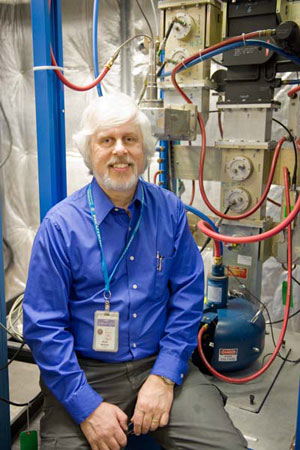 Rick Nelson, Engineering Division, earned an Award of Merit, for his work of art titled "Triad" at the Peninsula Glass Guild's 21st annual Juried Exhibition in January.
Staff engineer Rick Nelson has always been a tinkerer, fascinated by electricity, radios, cutting and soldering and putting things together. There's proof, in fact, in photo form: his family's Christmas card from 1955 shows him and his dad hovering happily over a short wave radio. He grew up, he says, in a classic 1950's small town. Buchanan, Mich., had barely 5,000 residents and included three hardware, two five & dime, two jewelry and three drug stores. It had a hotel, a clothing & shoes store, a grocery, lumber yards and was world headquarters for Clark Equipment. But today, as with many small towns, virtually all the retail is gone. His parents, both college educated, encouraged his interest in science, particularly electricity. He remembers clearly the science project he did with his mom — his first up-close experience with the electrolysis of water on the kitchen table. As a kid, he and a friend experimented with cooking hot dogs on electrified metal skewers and once tried the same thing with hamburgers. He devoured hobby magazines, built electronic circuits, bought parts for things and put them together. By high school, he was working in a radio and television repair shop, back when TVs still had tubes. He did a brief stint in Cub Scouts, but, he says, he was a true "science geek" with one artistic bent: he took organ lessons. It was a fortuitous pursuit back in the 1960's when being part of a band was a very cool thing. When a friend whose initials were P.J. started a band and asked him to be part of it, they came up with the name "PJ and the Nightshirts," complete with homemade costumes. When a local radio station recorded one of their gigs during his junior year of high school, it led to what would become his initial career as an on-air personality. When he went off to Michigan Technological University in Houghton, he became the voice of the dorm radio station. Which led, as things seem to in Nelson's life, to more jobs and ultimately to work at not one but two radio stations. He was an on-air personality, engineer and did voice work for commercials. He met his wife, Ali Rogan, in the mid-1970's while seated not so comfortably in a dentist's chair and she, a dental assistant at the time, took impressions of his mouth. She was so taken with him that she took an impression of the wrong teeth. They dated for seven years. In 1983, they designed their own wedding invitations; the front said "Finally…" in large letters. Along the way, while he was still working in radio, he and his brother (he also has two sisters) designed, made and sold an adapter/connector that could be used with an Osborne "portable" computer to hook it to a regular sized monitor, since this progenitor of today's laptops had a screen that was only 5 inches across. (The "portable" was the size of a sewing machine case.) By 1987 he was wondering about doing radio for the rest of his life. When his old friend from school, Tom Moore, was visiting in Michigan, he mentioned the work he was doing as the CEBAF Engineering Manager and asked if Nelson would be interested in coming down. Despite the fact that he had no idea where Newport News was and wasn't sure he'd care much for a climate with lots of humidity and little snow, he sent his resume. He was hired in June 1988 and was, by his estimate, about the 150th employee here. He laughs as he recalls how all the employee photos were on a wall in the VARC in those days and how his kept moving to the left — toward longevity — as others left and he stayed on. Now, he's gone from being part of the original crew getting the accelerator up and running to working on the high-power RF system that will add 10 RF zones for the 12 GeV Upgrade. Key to that effort is a new, higher-power klystron. The contract for the devices was awarded in April; see the story in this issue titled or the news release: JLab Awards $3.54 Million Contract. He’s been working on creating the specs for additional components and will oversee the procurement, construction, installation, testing and commissioning. Despite the intensity of his work, he pursues photography, which he took up as a kid and then returned to during college and glass art. Over the years, Ali moved her pursuits from dental to art and is now a glass artist with her own studio and gallery, has won numerous awards and teaches at the Governor’s School for the Arts in Norfolk and the Contemporary Art Center in Virginia Beach. That looked interesting to Nelson, so he took his tinkering skills to working with glass, much of it with "slumped" on metal foundations that he crafts himself. Ali encouraged Nelson to enter his work in shows. Several of his glass pieces have been exhibited at the Charles H. Taylor Art Center in Hampton and he has received awards, including Best in Show, at the d’art Center in Norfolk. His impressive glasswork speaks of this inveterate tinkerer's heart. Incorporated into his works are the parts and pieces of found objects — a satellite dish a neighbor was throwing away and lighthouse lenses — that come together in creations that marry the rigidity of metal with the fluidity of glass. By Judi Tull In Their Own Words With Theorist Huey-Wen Lin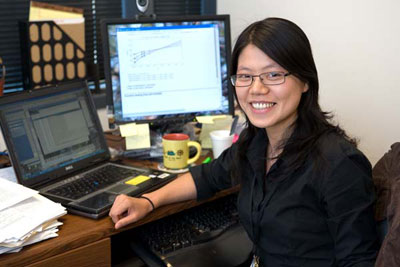 Huey-Wen Lin
I was born in the very small town of Toucheng in Ilan, Taiwan. Even though it was only two hours away from Taipei, most people there were not familiar with it. Now that a highway tunnels through the mountains, it’s the backyard of Taipei. My interest in science sprouted during my fifth year of elementary school. I had a very young and enthusiastic teacher for math and science, who encouraged us to learn outside the classroom and made solving equations a fun game with the other students. I was admitted to National Taiwan University to major in physics, where my classmates were accustomed to being the best. The first-year general physics requirement was usually a breeze for freshmen in the department. However, my professor decided to give us a very hard start by presenting much higher-level material than had ever been taught in that class before; many of us had a hard crash and started to doubt whether we had made the right choice of major soon after the first mid-term. I stayed and after a few adjustments, continued to do well. During my second year, I was offered a summer position in a lab where I worked with superconducting materials; I continued with that work until graduation. Late in my senior year, everything really hit me! If I wanted to continue in academics, I had to apply to grad schools abroad. Neither of my two brothers — one older, one younger — are in science; I was the weird kid in the family, and my parents had only let me attend university with the expectation that I would stay in our small town to teach. I applied to be a teaching associate at the university, which gave me time to prepare for applications and convince my parents to let me pursue my dream. Initially, I applied to grad schools mostly on the West Coast of the U.S., but my professor encouraged me to apply to Columbia University. In recent years, no one from Taiwan had been admitted, so I didn’t think my chances were good. I was quite surprised and excited when I got in. I moved 10,000 miles to New York, feeling isolated in an alien world at first, but the city has such a diverse cultural environment that I later became comfortable there. I had been encouraged to find a mentor for the first summer and was privileged to work with Horst L. Stormer on condensed matter experiments. However, after years working in condensed matter, I found myself without the passion I felt I needed to make it my career and started over from zero for research topics. It was when I met my adviser, Norman Christ, that I fell in love with lattice QCD (quantum chromodynamics). He is a brilliant physicist, full of enthusiasm and ideas; I enjoyed every moment of our discussions. Columbia was also where I met my husband, Saul Cohen. I had known him since 2001 and seen him every day at work, being in the same group and living only a block apart. Even so, it was only during the final year of my Ph.D. that we finally had a real conversation, at a party. We were married in the summer of 2006 and were very lucky to find two postdoctoral fellow positions here. I came to Jefferson Lab in the fall, and he followed in May 2007, so we were not apart for very long. After being spoiled by the many diverse restaurants and activities in New York, coming to Newport News was an adjustment. Saul and I came to enjoy the outdoors and have tried to visit every park in the area. We’ve taken up bird-watching and branched into photography. We’ve been to several national parks and wildlife refuges like the Everglades and Shenandoah in our hunt for interesting birds. I will be leaving JLab for an assistant professorship at the University of Washington this summer, while Saul moves to Boston. This is a classic "two-body problem" for us, but we hope the best for convergence in the near future. Being here has been a wonderful experience for me. I’ve really enjoyed the research environment of local experts, constant visitors from around the world and many topical workshops on my research interests. My colleagues in the Theory Group have been very encouraging and supportive of my research. I feel very lucky and proud to be part of the JLab family. As told to Judi Tull The Future of Rare Isotope Science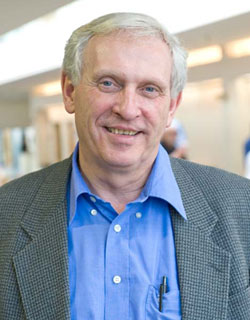 Konrad Gelbke is the director of the National Superconducting Cyclotron Laboratory at Michigan State University.
Konrad Gelbke is the director of the National Superconducting Cyclotron Laboratory at Michigan State University. Supported by the U.S. National Science Foundation, the facility is billed as the nation's foremost rare isotope accelerator facility for nuclear physics research. Recently, the NSCL was named as the future site of the $550 million Facility for Rare Isotope Beams, a project funded by the U.S. Department of Energy. The research conducted at FRIB will involve experimentation with intense beams of rare isotopes — short-lived nuclei not normally found on earth — and is expected to advance critical applications in the areas of materials science, medicine, and stockpile stewardship. The facility is expected to take about a decade to design and build. It will provide research opportunities for an international community of approximately 1000 university and laboratory scientists, postdoctoral associates and graduate students. Gelbke visited Jefferson Lab on March 11; he met with lab representatives and discussed NSCL's plans for FRIB during a colloquium.
Milestones: March – April 2009Hello Goodbye These Milestone entries, listed alphabetically, are full-time, term, casual and student actions posted by Human Resources during March and April 2009. For more information about employment at JLab, visit: http://www.jlab.org/div_dept/admin/HR/index.html . Jefferson Lab Community Mourns the Loss of Cornelius Bennhold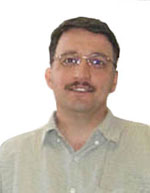 Cornelius Bennhold
The Jefferson Lab community was saddened to learn of the untimely passing of Cornelius Bennhold, a professor at The George Washington University who was an active and effective participant in the research program at Jefferson Lab since its beginnings. A copy of the tribute to Professor Bennhold written by his colleagues has been posted on the Jefferson Lab website. Colleagues and friends of Bennhold are encouraged to share anecdotes and expressions of condolence or sorrow, or of celebration for the life that Cornelius lived via the websites identified in the tribute.
Book Co-authored by JLab User Featured in The New York Times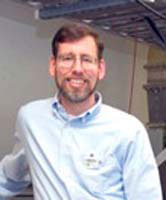 Lawrence Weinstein
Lawrence Weinstein, JLab user and a professor of physics at Old Dominion University, and John A. Adam, a professor of mathematics at ODU co-authored a book is titled "Guesstimation: Solving the World's Problems on the Back of a Cocktail Napkin." Writer Natalie Angier reviewed the book for the New York Times in a March 30 article titled: The Biggest of Puzzles Brought Down to Size. Weinstein and Adams offer a wide and often amusing assortment of mental teasers in their book, which was published through Princeton University Press, 2008. The February 2009 issue of Physics Today also included a review of the book, by Harvey S. Leff, California State Polytechnic University, Pomona.
|
|
The On Target newsletter is published monthly by the Thomas Jefferson National Accelerator Facility (Jefferson Lab), a nuclear physics research laboratory in Newport News, Virginia, operated by Jefferson Science Associates, LLC, for the U.S. Department of Energy's Office of Science. Possible news items and ideas for future stories may be emailed to jlabinfo@jlab.org, or sent to the Jefferson Lab Public Affairs Office, Suite 15, 12000 Jefferson Avenue, Newport News, VA 23606
|


 Accelerator technology is undergoing a renaissance at Jefferson Lab. A new section of the accelerator, called Renascence, features accelerator cavity technology that will provide the backbone of the 12 GeV Upgrade....
Accelerator technology is undergoing a renaissance at Jefferson Lab. A new section of the accelerator, called Renascence, features accelerator cavity technology that will provide the backbone of the 12 GeV Upgrade.... The U.S. Department of Energy announced in March that Jefferson Lab will receive $75 million from President Obama's American Recovery and Reinvestment Act to fund construction of JLab's 12 GeV Upgrade project and to modernize infrastructure..........
The U.S. Department of Energy announced in March that Jefferson Lab will receive $75 million from President Obama's American Recovery and Reinvestment Act to fund construction of JLab's 12 GeV Upgrade project and to modernize infrastructure.......... Dust off those running shoes! The 24th annual Jefferson Activities Group Run-A-Round will be held Wednesday, May 20 from 3-6 p.m. Jefferson Lab staff, users, full-time contractors and immediate family members are invited to participate......
Dust off those running shoes! The 24th annual Jefferson Activities Group Run-A-Round will be held Wednesday, May 20 from 3-6 p.m. Jefferson Lab staff, users, full-time contractors and immediate family members are invited to participate......